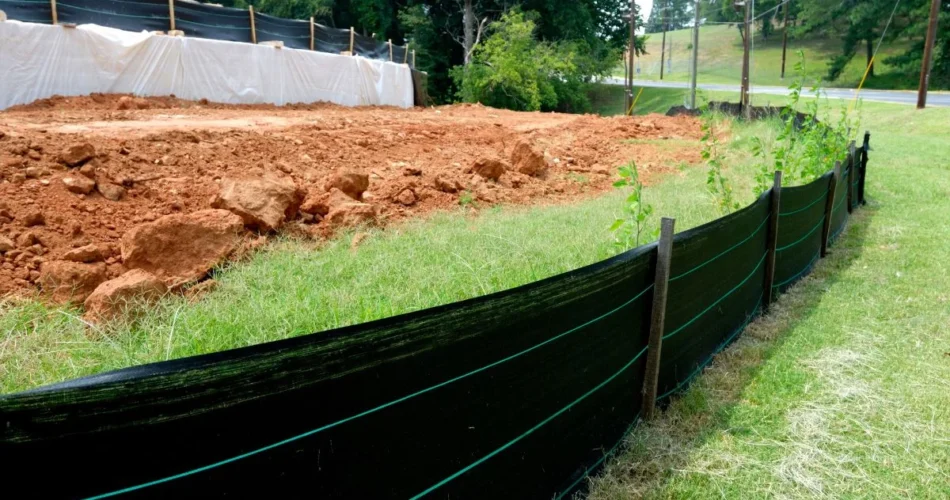When choosing the right type of silt fence for your project, it’s essential to consider factors such as soil type, slope gradient, and expected water flow. Different types of fences include standard grade fabric fences, high-grade fabric fences, wire-backed fences, and compost filter sock barriers. Standard grade fabric fences are cost-effective options suitable for low-flow areas with minimal soil disturbance. High-grade fabric fences offer enhanced durability and strength for more challenging conditions.
Wire-backed fences provide additional support in areas with higher erosion risk or increased sediment load. Compost filter socks are biodegradable alternatives made from organic materials ideal for environmentally sensitive projects. Before selecting a silt fence type, assess the specific requirements of your site to ensure optimal performance and compliance with regulations.
Table of Contents
Understanding Different Types of Silt Fences
Silt fences come in various types, each designed to cater to specific project needs. The most common type is the traditional fence made of geotextile fabric supported by wooden or metal posts. This type is effective for controlling sediment runoff on construction sites.
Another option is the compost filter sock, which consists of a mesh tube filled with organic materials like wood chips or compost. This type offers natural filtration and can be more environmentally friendly.
Wire-backed fences are sturdy options that combine wire mesh with geotextile fabric, providing extra support and durability in high-flow areas. They are ideal for projects dealing with heavy sediment loads.
Choosing the right type of fence depends on factors such as soil composition, slope steepness, and water flow patterns on your site. By understanding the different types available, you can select the most suitable option for your project’s specific requirements.
Factors to Consider When Selecting a Silt Fence
When selecting a silt fence for your project, there are several important factors to consider. The first thing to evaluate is the type of soil and terrain where the fence will be installed. Different types of fences are designed for specific soil conditions, so understanding your site’s characteristics is crucial.
Another key factor to take into account is the flow rate of water in the area. The fence you choose should be able to effectively filter sediment from runoff while allowing water to pass through at an appropriate rate.
Consider the length and height requirements as well. Ensure that the dimensions of the silt fence align with local regulations and industry standards for erosion control on your site.
Additionally, think about factors like durability, UV resistance, and ease of installation when making your decision. Choose a high-quality product that will withstand environmental conditions and provide long-lasting protection for your project.
Installation Tips and Best Practices
When it comes to installing a fence for your project, there are key tips and best practices to keep in mind. Ensure that the fence is installed downhill from the disturbed area to catch sediment runoff effectively. Properly secure the fence posts with stakes every 4-6 feet and make sure they are driven deep into the ground.
Next, overlap adjacent sections of the silt fence by at least 12 inches and securely fasten them together using wire or ties. It’s crucial to inspect the installation regularly to check for any damages or signs of wear and tear. If any issues are found, promptly repair or replace damaged sections to maintain effectiveness.
Always follow manufacturer guidelines when installing a fence and consider factors such as soil type, slope gradient, and expected water flow. By adhering to these installation tips and best practices, you can ensure that your fence functions optimally in minimizing erosion and protecting the environment.
Maintenance and Longevity of Silt Fences
When it comes to maintaining fences, regular inspections are key to ensuring their longevity and effectiveness. Inspect the fence frequently for any signs of damage or wear, such as holes, tears, or sagging sections. Addressing these issues promptly can prevent sediment runoff and potential environmental harm.
It’s essential to keep the area around the silt-fence clear of debris that could obstruct its function. Regularly remove any sediment buildup along the fence line and ensure proper drainage channels remain unobstructed. This will help maintain the efficiency of the silt-fence in controlling erosion and sedimentation on your project site.
In addition to visual inspections, consider scheduling routine maintenance tasks like reinforcing weak areas or replacing worn-out stakes. By staying proactive with upkeep, you can extend the lifespan of your silt-fence and minimize risks associated with soil erosion – a win-win for both your project goals and environmental stewardship efforts.
Environmental Impact and Compliance
Silt fences play a crucial role in preventing sediment runoff and protecting the environment. By choosing the right type of fence for your project, you can minimize the impact on surrounding ecosystems and ensure compliance with environmental regulations.
When considering the environmental impact of fences, it’s important to evaluate factors such as material biodegradability, durability, and effectiveness in capturing sediment. Opting for biodegradable fence options can reduce long-term harm to wildlife and habitats while still effectively controlling erosion.
Compliance with local regulations is key when installing fences. Different areas may have specific requirements regarding fence design, installation techniques, and maintenance protocols. Ensuring that your project meets these standards not only protects the environment but also avoids potential fines or penalties.
By prioritizing environmental impact considerations and adhering to compliance guidelines, you can make a positive contribution to sustainable construction practices. Choose silt fences that align with eco-friendly principles without compromising on effectiveness or regulatory requirements.
Conclusion
Choosing the right type of silt fence for your project is crucial to effectively control sediment runoff and protect the environment. By understanding the different types of fences available, considering key factors during selection, following installation tips and best practices, and prioritizing maintenance for longevity, you can ensure that your project meets environmental compliance standards.
Remember that fences play a vital role in mitigating erosion and preserving water quality. By making informed decisions when it comes to selecting and maintaining fences, you not only safeguard your project but also contribute to sustainable construction practices. Keep these considerations in mind as you embark on your next construction or landscaping endeavor to make a positive impact on both your project’s success and the environment.

